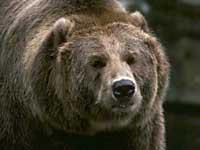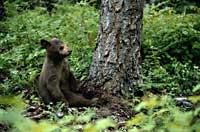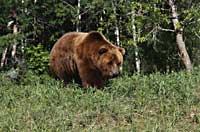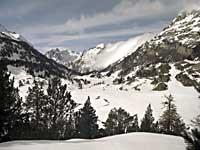The endangered Pyrenean bear

It is time to eat and eat, to fatten. To combat the long winter sleep they must accumulate the maximum reserve of food in their solid body. And they are going to spend the winter in the moat and will not leave until spring. Then yes, of course and hunger will go out raging.
Thus Canelle came out in the spring of this year, ending hunger. And it did not come out alone, but had a newborn baby. It was good news for the Pyrenean bears, as another bear was born for the new generation. A relatively small generation, considering that there are fewer and fewer bears in the Pyrenees.
Most young bears are descendants of bears from Slovenia. About eight years ago, in 1996 and 1997, the French government brought three bears from Slovenia. The aim was for these bears to reproduce with or among the natives. The Slovenian bear belongs to the same species as the Pyrenean bear ( Ursus Artus), after all it is a brown bear, but among these subspecies there was no contact between centuries.
Formerly the bear lived all over Europe and in some way the subspecies hardly differed. But as man proliferated, the bear was hiding in the mountains and the subspecies lost their mark. In some places they have survived with dignity and are currently not in danger of extinction.

Man has oak as a great hunting treasure and, being attacked by herds, is also a feared rival. For this reason, it has disappeared in many places and in others it is in grave danger, as is the case of the Pyrenees. So they brought the three Slovenian bears because the Pyrenean bear was about to disappear. The doubt was whether those bears could live in the Pyrenees. But they had no problems adapting to the place, as the Pyrenees seem to be a unique place.
But the obstacle was more human than the environment. And one of the three bears, the female herself, was shot dead by hunters. Thus, one male and another female survived. And, even though they were freed away, they found and proliferated. This Slovenian female has since grown many growths. Among them a beautiful male named Nere.
Nere grew up east of the Pyrenees, but as he arrived he did so west. He reached the territory where the old Pyrenean bear named Papillón lived, and the place liked him, because it seems that he still lives in that area. Papillón had to leave his territory. According to experts, he was about thirty years old, he was toothless and had a clumsy march.
Papillon began to create problems for the shepherds: he attacked the flocks and, although he did not kill many sheep, he would probably abandon the flock upside down: scared lost sheep, abortions... So they put a transmitter on him to find out where he was going. But, as mentioned, in Papillo he was very old and died in summer, old.

Papillon covered Canelle several times. But experts believe that the breeding that Canell has left will be that of Nerea, who occupied the place of Papillon in every way. I am a young and beautiful boy.
But Camille is also there. Although they claim to be about twenty years old, this Pyrenean bear is still in shape and say it is very fast. If breeding out of Camille, it would be from the area. But there is more chance of being from Nerea, so the breeding is almost certainly half Pyrenean and half Slovenian.
Therefore, only two native bears remain: Camille and Aspe D’Ouest. Both are males and, of course, are not able to maintain the subspecies. Bears from Slovenia have been more successful in breeding and already form a fairly large but not enough group, and from Slovenia they will have to bring more bears.
Now all eyes look at the new generations and, above all, at the breeding of Canelle. It is not known if it will survive. He only has between ten and eleven months and still had to be with his mother: eat the beech acorn to fatten and spend the winter in a lethargy. In fact, until May next year the child had to be with his mother.

Two offspring a few years ago younger than that breeding managed to advance after the death of hunting mothers. These two offspring counted, logically, with the collaboration and the company. Canelle's offspring does not seem, for the moment, to have the company of another bear.
Canelle's death leaves the brood alone. He eats and eats by order of instinct and enters the winter dream. We will see it in the spring that is able to spend only the winter. Then, experts will look for clues about their breeding. And anyone can know if it is female or male, if it survives, of course.
Published in 7K.
Buletina
Bidali zure helbide elektronikoa eta jaso asteroko buletina zure sarrera-ontzian











